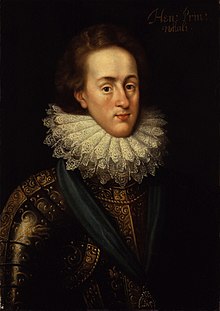Henry Frederick, Prince of Wales
| Henry Frederick | |
|---|---|
| Prince of Wales Duke of Cornwall Duke of Rothesay |
|

Henry Frederick in c. 1610
|
|
| Born | 19 February 1594 Stirling Castle, Scotland |
| Died | 6 November 1612 (aged 18) |
| Burial | Westminster Abbey |
| House | Stuart |
| Father | James VI and I |
| Mother | Anne of Denmark |
Henry Frederick, Prince of Wales (19 February 1594 – 6 November 1612) was the elder son of King James VI and I of England and Scotland by his wife, Anne of Denmark. His name derives from his grandfathers: Henry Stuart, Lord Darnley, and Frederick II of Denmark. Prince Henry was widely seen as a bright and promising heir to his father's thrones. However, at the age of 18, he predeceased his father when he died of typhoid fever. His younger brother Charles succeeded him as heir apparent to the English, Irish and Scottish thrones.
Henry was born at Stirling Castle, Scotland and became Duke of Rothesay, Earl of Carrick, Baron of Renfrew, Lord of the Isles and Prince and Great Steward of Scotland automatically on his birth. His father placed him in the care of John Erskine, Earl of Mar, and out of the care of the boy's mother, because James worried that the mother's tendency toward Catholicism might affect the son. Although the child's removal caused enormous tension between Anne and James, Henry remained under the care of Mar's family until 1603, when James became King of England and his family moved south. Henry's baptism on 30 August 1594 was celebrated with complex theatrical entertainments written by poet William Fowler and a ceremony in a new Chapel Royal at Stirling purpose-built by William Schaw.
One of his tutors until he went to England was Sir George Lauder of the Bass, a Privy Counsellor – described as the King's "familiar councillor" – and he was also tutored in music by Alfonso Ferrabosco the younger. Henry's tutor Adam Newton continued to serve the Prince in England, and some Scottish servants from Stirling were retained, including poet David Murray.
...
Wikipedia
